The Duncan Garner episode: Immigration, population and the challenge of 'social cohesion'

Now it is the self-service island in the middle of a department store in Auckland (Kmart) – after the much-touted Auckland's public infrastructure, roads, motorways and the housing market – that is failing to cope with the pressure of the people (read immigrants).
Another 'public space' in the midst of bustling Auckland city (shopping malls are very much part of public space), which is apparently reeling under the pressure of immigration and hence unwelcoming of immigrants.
At least this is what comes out from the latest spat around The AM Show host Duncan Garner's peek into New Zealand's future even if that was not his intention, as Mr Garner has strenuously claimed.
The latest outburst follows his travails at a local Kmart store in Auckland where he saw a "massive human snake" at the self-service island near the middle of the store and made a passionate call out for better planning on immigration and population.
There was nothing implausible about the argument except that Mr Garner saw "Indians, Pakistanis, Sri Lankans, Syrians, and many others," and this made him think about the "changing face of New Zealand at the crossroads."
However, what followed from here in that passionate column was a structured argument about the side effects of the record level of immigration that New Zealand is currently facing – as if the number of immigrants was the only problem.
At least this is what the remaining part of Mr Garner's column implied.
Many numbers and statistics were neatly rolled out to substantiate the initial observation of "massive human snake."
"New Zealand's population grew by 100,400 to the June 2017 year," Mr Garner wrote.
"Predictions show we will have 6.3 million people by 2038. There'll be more Asians than Maori." Mr Garner argued.
"Get this wrong, and New Zealand could be an international cot case of broken cities, poor planning, congested highways and stolen dreams," Mr Garner roared.
Clearly, a major part of Mr Garner's column appeared backing up the initial claim that it was all about the number of immigrants and over-population that was a concern for the future of New Zealand.
Only if we all were as naive as Mr Garner had hoped us to be.
There was nothing to back up the most provocative part of that initial observation – the demographic profile, or ethnicity, or place of origin of those immigrants, which in Mr Garner's worldview were changing the face of New Zealand.
It is noteworthy that Mr Garner failed to note the presence of Pakeha or Maori in that departmental store, possibly contributing to his discomfort in any manner about New Zealand's future.
As if the number of Pakeha, which is also increasing largely because of immigration, does not cause any alarm in Mr Garner's otherwise serene view of New Zealand's future.
It is only the number of new immigrants or Asians or essentially non-white people that is a concern.
To say that this view is problematic will be an understatement of the challenge that New Zealand will be really facing in the near future than what many bombastic political commentators are claiming.
What is the more pressing challenge for the future of the New Zealand, effective planning for immigration and population or maintaining an effective 'social cohesion'?
Some enthusiastic observers like Duncan Garner are hastily concluding the former over the later as the major challenge for New Zealand in the near future.
However, unmistakably 'social cohesion' is a bigger challenge and should be treated as a bigger challenge to respond than just aiming to get the planning on immigration and population right.
Social cohesion is not just a new buzzword in our modern societies; rather it is emerging as a major challenge in many immigrant nations like New Zealand where people from diverse social, ethnic and cultural backgrounds are increasingly living together.
The ability and willingness of members of society to integrate and cooperate with each other in order to prosper and survive collectively is a measure of society's social cohesion.
A cohesive society fights exclusion and marginalisation, promotes trust and creates a sense of belonging among the members of the society.
The current narrative around immigration could possibly exacerbate social exclusion by repeatedly questioning the sense of belongingness among the new immigrants in this country.
This is certainly posing bigger challenges of disturbing social cohesion of our country in the guise of addressing the problem of population increase and pressure on infrastructure.
Indeed, the issue of increase in the record level of immigration needs an oversight.
However, nothing has to come at the cost of disturbing the delicate fabric of our social cohesion, where everyone is wrongly encouraged to see the cause of any problem as "us" versus "them."
This is exactly what Mr Garner is doing when he asserts callously, "Let's design our country to make it better for us. Bring in the people by all means but send them to where we need them. Let us not give them what they need from us so easily.”
It is the time that we get our priorities right.
Catching up on infrastructure and managing the population is not that big a challenge as is maintaining an effective social cohesion.
The cities and states are not only broken by poor planning and congested highways, but they are also broken by disturbing the delicate social cohesion by calling out unnecessarily on one set of people over others.




